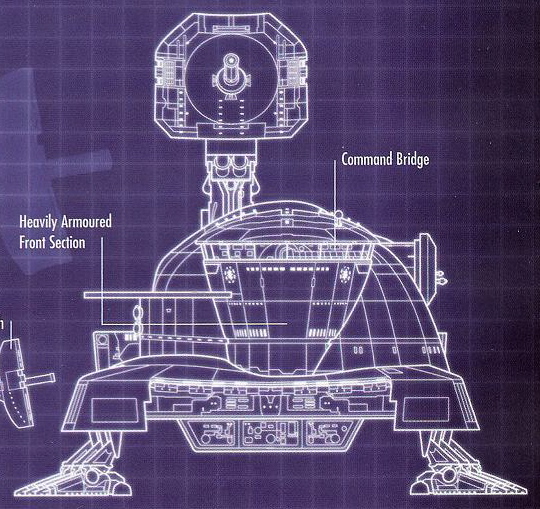The Self-Propelled Heavy Artillery (SPHA) walker, also known as the Mobile Assault Cannon (MAC), was a modular heavy artillery unit used by the Grand Army of the Republic during the Clone Wars, and by the Galactic Empire afterward. It bore a resemblance to the smaller RX-200 Falchion also utilized by the Republic during the Clone Wars.

An aft view of a SPHA
A Self-Propelled Artillery Walker (SPHA) had twelve legs that served as mobile support structures. Unlike smaller walkers, such as the AT-TE, SPHA units were unable to be carried into battle by LAAT/c gunships because of their large size and weight. Instead, they were deployed directly from landed Acclamator-class assault ships, which could carry 36 of the artillery platforms.
In battle, SPHA walkers usually received orders from ground-based command posts, which provided a less isolated and more in-touch view of the battlefield than the towering walkers. In addition, SPHA units had a complement of 30 clone troopers, which could be deployed rapidly via a dorsal hatch. In seconds, the soldiers could disembark the vehicle and secure the area immediately around the walker, providing protection from enemy infantry and other light units.

An frontal view of a SPHA with a clone trooper for scale.
The SPHA walker chassis served as the basis for a number of different weapons platforms, though the best-chronicled version was the turbolaser (SPHA-T) configuration. This variant's main weapon was a heavy turbolaser cannon, capable of causing extreme direct fire damage to large or slow-moving targets. The turbolaser boasted tremendous range and was capable of penetrating deflector shields.
The primary disadvantage of this powerful weapon was that it was incapable of providing indirect fire support to out of sight locations, a problem remedied in other models. Another disadvantage was that the weapon could only be charged to a certain level—upon firing such shots, they had to be replaced with charged guns from the rear lines.
Some of these other variants deployed during the Clone Wars include the ion cannon (SPHA-I), anti-vehicle laser (SPHA-V), concussion missile (SPHA-C), thermobaric burst (SPHA-F), and mass-driver (SPHA-M). Also, these units had the disadvantage of ammunition, as it would run out if not managed properly. Some of these model variations included 12 retractable antipersonnel blasters, necessitating an additional 10 gunners to the command crew of 15.

An SPHA-T walker battery protected by columns of clone troopers and AT-TEs.
Developed by Rothana Heavy Engineering, a covert subsidiary of Kuat Drive Yards, the SPHA walker was designed to fulfill the role of mobile ground-based long-range artillery support.
It complemented the two other key components of the Republic's military strategy—the AT-TE walker and the LAAT/i gunship. In a typical attack, the AT-TEs and LAATs would spearhead the assault, establishing a forward base and allowing heavier support forces (such as SPHA walkers) to consolidate gains and provide reinforcements.
The power usage of the turbolaser cannon in the SPHA-T variant dictated the design of the other parts of the vehicle.

An SPHA-T
Designers rejected a complex turret mechanism, choosing instead to rely on the entire walker repositioning itself in order to adjust for different firing coordinates. Because of the fixed weapon positioning, as well as the slow firing speed of the turbolaser, the SPHA was unable to track rapidly moving targets, such as speeders or small atmospheric craft. Like other walkers, the use of articulated legs prevented the SPHA from being vulnerable to anti-repulsorlift weapons, at the cost of some mobility.
The result of this development process was a walker that possessed a very capable capital ship-class weapon that was hampered by its low mobility. This low mobility was exacerbated by the fact that SPHA walkers were equipped with heavy armor, especially in the frontal area of the vehicle around and just below the command deck. This armor was necessary to protect the vehicle's reactor core from enemy fire, as any meltdown and subsequent explosions would cause tremendous collateral damage.
The Galactic Empire later developed a more compact version, the SPMA, which was more mobile and compact, thanks to weight-reducing advancements in technology.

SPHAs concentrate fire on a fleeing Lucrehulk-class Core Ship.
The SPHA, particularly the SPHA-T, first appeared in the First Battle of Geonosis where it was instrumental in bringing down several Lucrehulk-class core ships and Hardcell-class interstellar transports.
SPHA units were used throughout the Clone Wars, seeing action in surface battles such as the Battle of Cato Neimoidia, the Battle of Muunilinst—where many were destroyed by the nimble IG lancer combat droids—, the Battle of Rhen Var, and the Second Battle of Tatooine.

An SPHA-T fires its turbolaser at a Munificent-class star frigate from inside the hangar of a Venator-class Star Destroyer.
At the suggestion of Anakin Skywalker, many Venator-class Star Destroyers of the Open Circle Fleet had SPHA-T turbolaser cannons installed inside their ventral hangar bays, where they were used effectively during the Battle of Coruscant, especially against enemy Munificent-class star frigates.
The SPHA-line walkers continued in service in the early years of the Galactic Empire, until the SPMA-line was developed, with the SPMA vehicles being faster and more maneuverable than the cumbersome SPHA-Ts.

A schematic of the SPHA-T
Concept art of the SPHA-T was drawn by Concept Design Supervisor Erik Tiemens. He initially imagined a treaded vehicle, but George Lucas changed it to a walker. The SPHA's production name was "Clone Tank A".
In both Star Wars: Attack of the Clones: The Visual Dictionary and Star Wars: The Complete Visual Dictionary, the SPHA-T's turbolaser is incorrectly labeled as a troop hatch. Also, in The New Essential Guide to Vehicles and Vessels, the SPHA-T is incorrectly said to be driven by multiple treads. It is in fact a walker, driven by twelve legs.
The size of the vehicle is somewhat indiscernible, as the 140-meter length apparently from The Official Star Wars Fact File 71 does not match the size seen in Star Wars: Episode II Attack of the Clones, or the dimensions used in The New Essential Guide to Vehicles and Vessels physically.